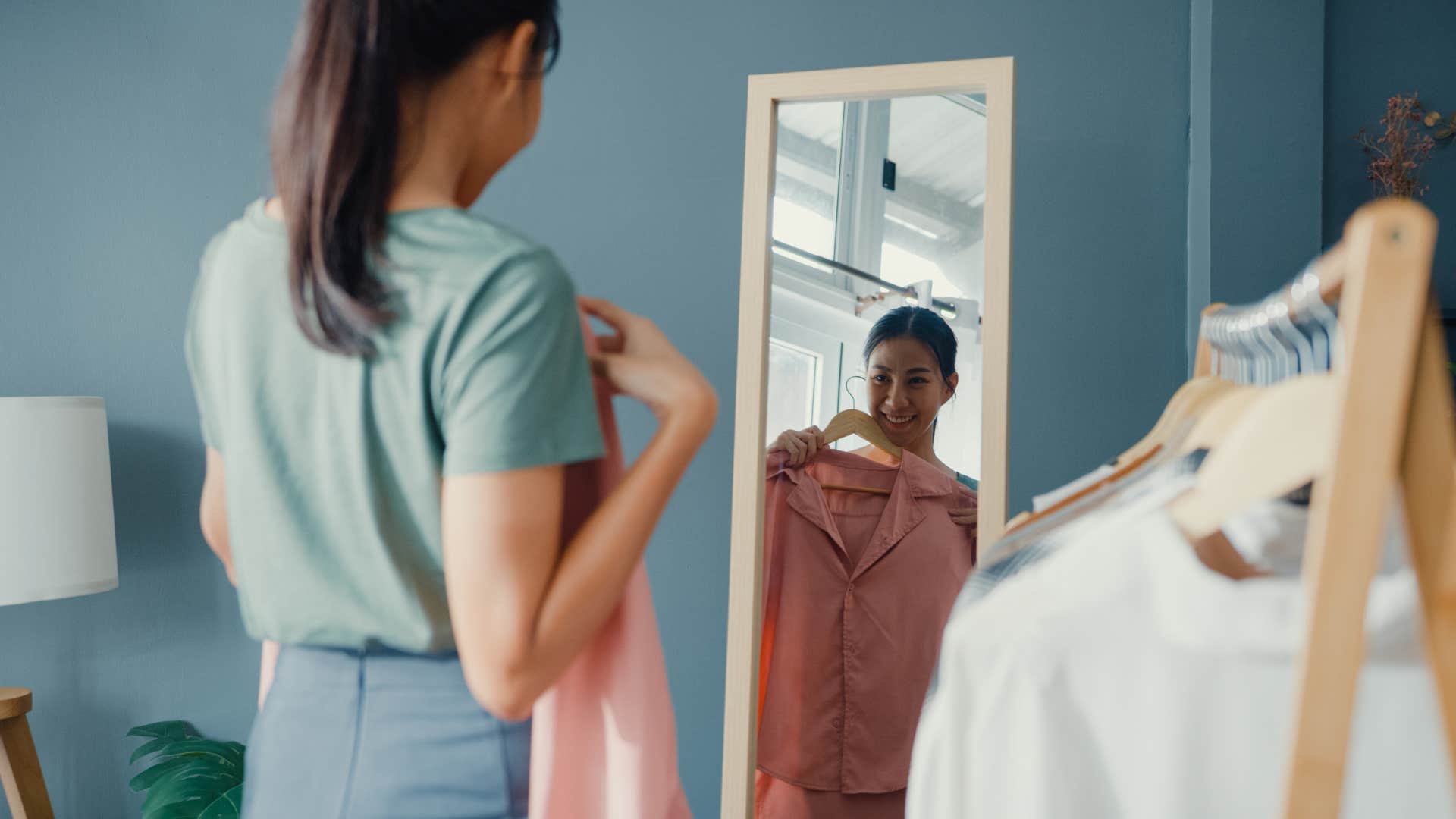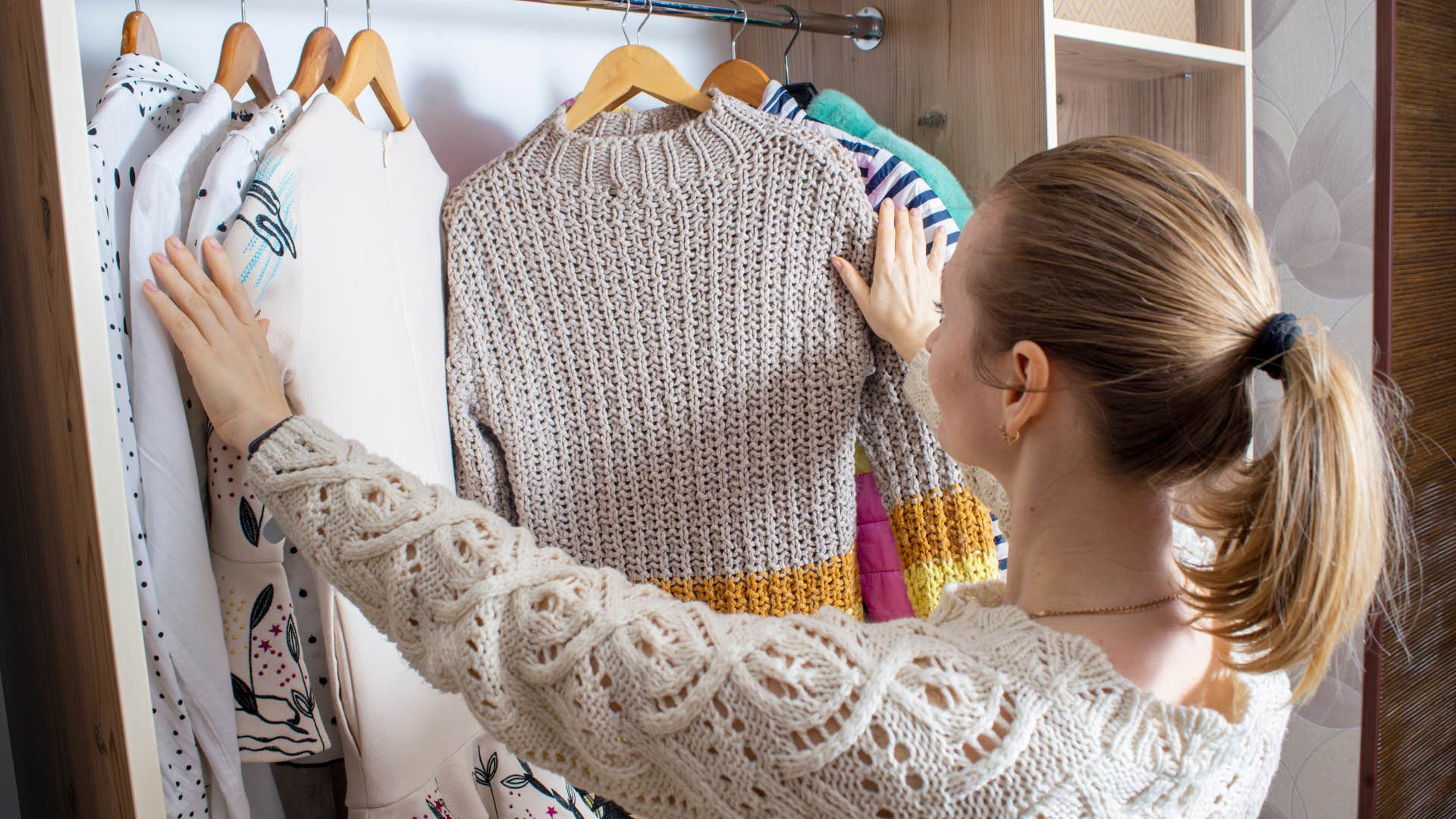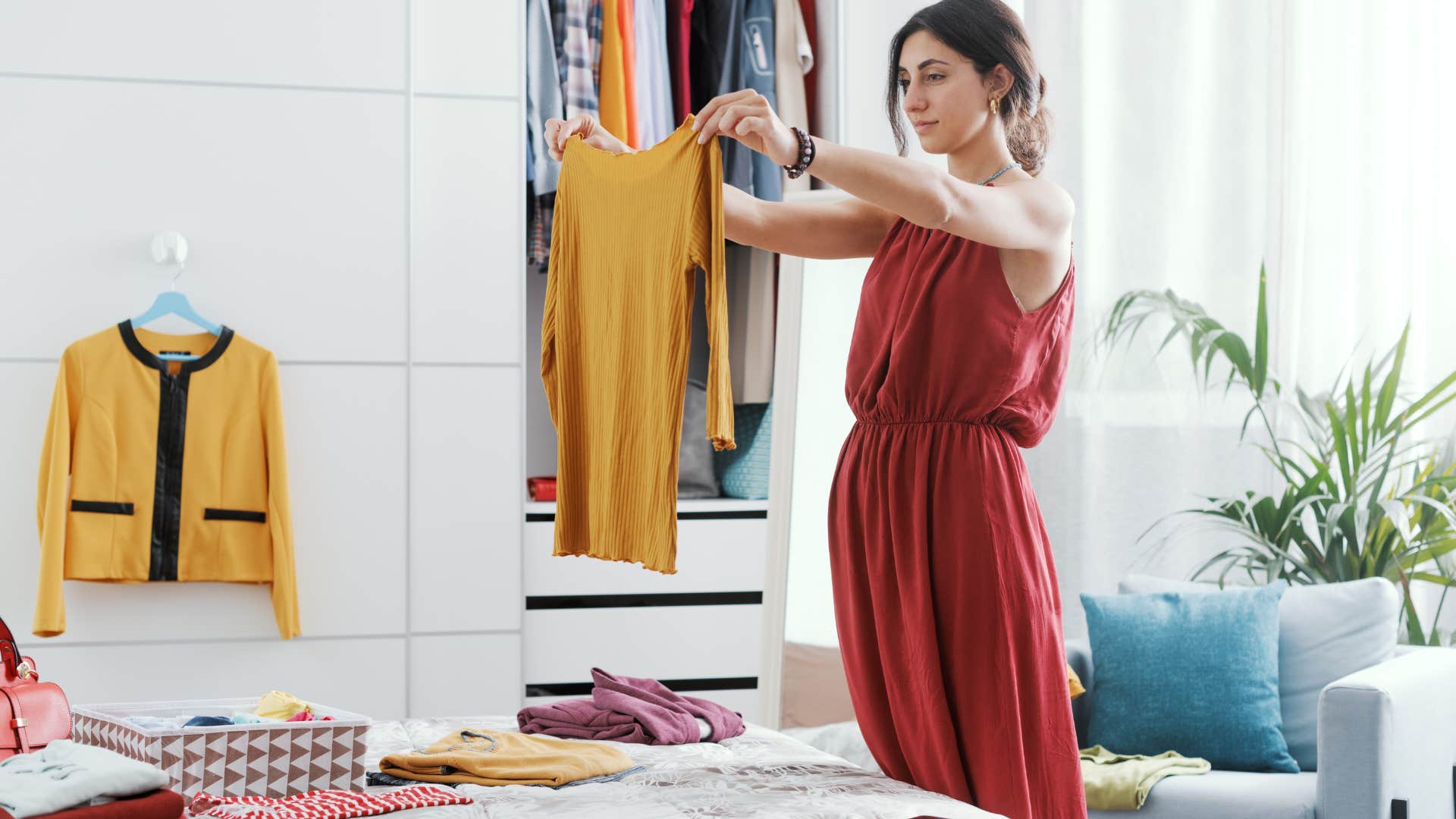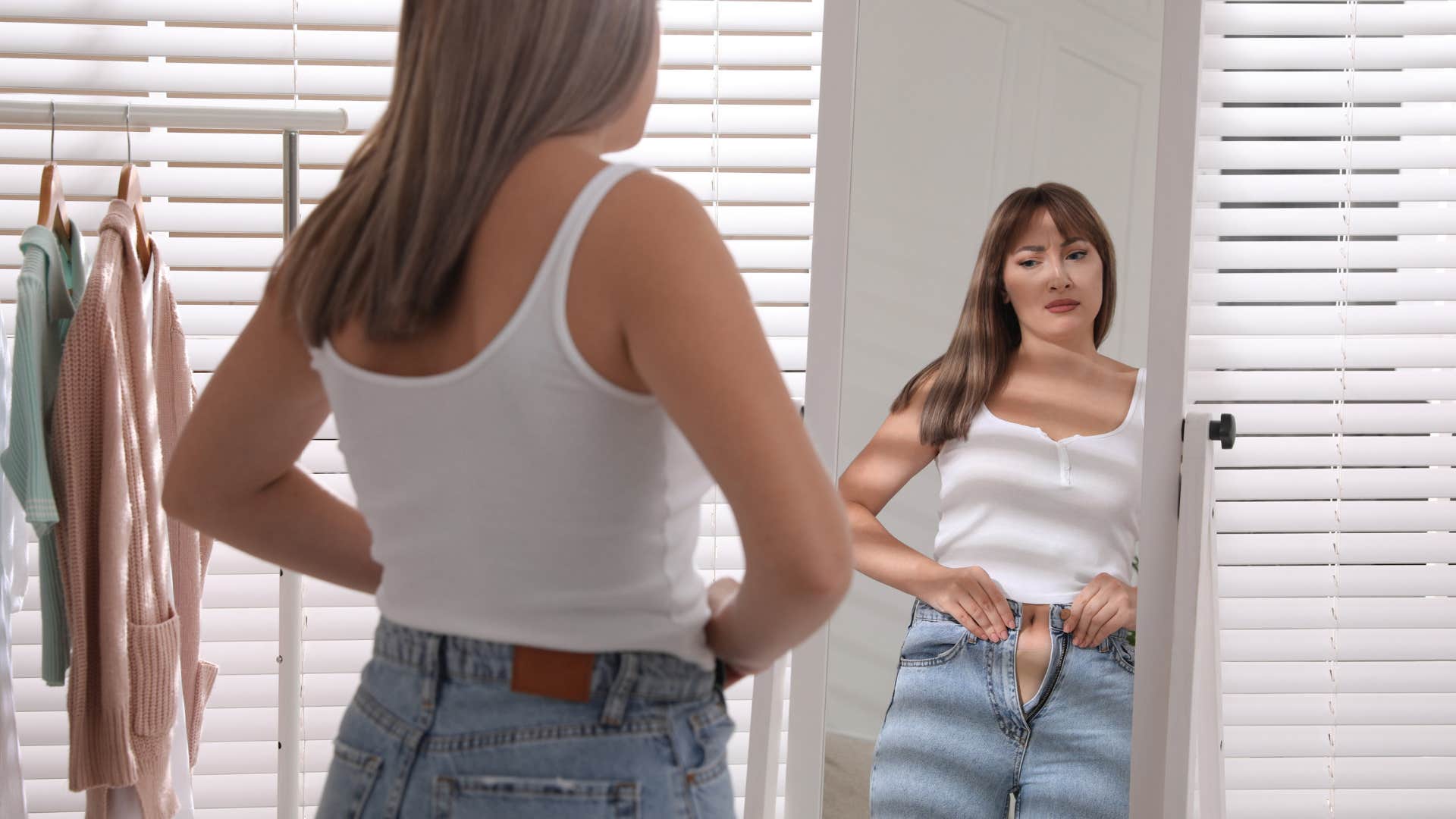People Can Tell You're Bad With Money If You Have These 11 Things In Your Closet
Your closet can reveal your spending habits.
 GaudiLab | Shutterstock
GaudiLab | Shutterstock There are a variety of different ways people can identify individuals who might not be good with spending and saving their money. From items kept strictly for aesthetic purposes to cheap jewelry, people can tell you're bad with money if you have these things in your closet. Your bank account balance might be inching closer and closer to the negatives, but from seeing what's hanging up in your closet or stuffed in the corner on the floor, it can tell if your spending habits might not exactly match up with your financial reality.
Most us are guilty of buying something we don't need, only wearing it once, or even just letting it hang in our closet for months with the tags still on. All of these little choices add up and, before you know it, your closet becomes a symbol for the impulse buys you gave into. It also shows that you might not be someone who's as good with money as you want others to believe. There's nothing wrong with wanting to have a stylish and up-to-date closet, but there's a big difference between making smart and reliable purchases and just splurging when you know you shouldn't.
People can tell you're bad with money if you have these 11 things in your closet
1. Designer bags for aesthetic
 PeopleImages | Shutterstock
PeopleImages | Shutterstock
According to a survey from YouGov, an estimated 14% of consumers are likely to spend their money on some sort of luxury bag. For many people, it feels like a monumental moment to buy your first designer bag, but it says more about your financial habits if you're someone who's only buying a luxury bag for aesthetic purposes and to not actually get any wear from it.
Designer bags are not meant to be trophies, but are meant to actually be worn out. Holding onto them just for the brand name alone starts to feel as if you paid all of that money just to say you have a Louis Vuitton or Gucci bag, rather than the value of the actual product.
When you display these bags in your closet, it can hint to people that you have no problem spending upwards of hundreds of dollars on a bag that you plan on never using, which means your financial habits can be called into question.
2. Multiple versions of the same outfit
 Tirachard Kumtanom | Shutterstock
Tirachard Kumtanom | Shutterstock
It's always nice to have a few basics in your closet that can be rotated with any kind of outfit. Things like a denim jacket, a white tee, a plain black skirt, or some neutral-colored heels.
However, you definitely don't need to be buying five of the same black tank tops that'll only take up space and effectively drain your wallet. If you're taking a peek into someone's closet and notice that they tend to have nearly a handful of identical pieces, you'll start to wonder what the point of that is.
These individuals might convince themselves that it's practical and is there to round out their wardrobe, but in reality it's just clutter disguised as being efficient. You don't need multiple versions of the same outfit or piece. It might actually just be a careless decision with your finances and, instead, you should be buying things that you know you'll actually wear and enjoy.
3. Clothes with tags still on them
 YAKOBCHUK VIACHESLAV | Shutterstock
YAKOBCHUK VIACHESLAV | Shutterstock
People can tell you're bad with money if you have clothes with the tags still attached in your closet. It's normal to buy something we really like without thinking, but despite promising ourselves that we'd wear it soon enough, it just sits in the closet, collecting dust with the tag still dangling.
A poll by Stitch Fix United Kingdom found that people have an average of $268.44 worth of unworn clothes in their closet, with only 6% admitting to having actually worn everything in their closet at least once. When your closet is stacked with multiple articles of clothing that all still have their tags on, it's not just an issue with figuring out how to style them, but an actual spending problem.
The tags are a reminder that you might have a bit of an impulse problem and enjoy the excitement of shopping but not the actual use of the item. Every unworn piece represents the money you spent and the fact that you haven't bothered to return it either when you've realized you don't actually like that item at all.
4. Broken hangers from overstuffing
 Serhii Krot | Shutterstock
Serhii Krot | Shutterstock
There comes a point when you start to realize that you might actually have a spending problem, and it usually comes with the amount of room left in your closet. But if you take a look into someone's wardrobe to see that their hangers are hanging on by a thread and snapping under the weight of having an overstuffed collection, that might be a sign of how bad at money they are.
When you're someone that has no problem repeatedly buying things and chasing all of the latest trends, it means you're only filling your closet with pieces that'll most likely never see the sun. Every broken hanger is a small but telling representation of how much your spending has lapped circles around your ability to even manage all of these clothes.
There really does come a point when you have to realize that splurging and collecting these items of clothing is doing you more harm than good, especially for your poor hangers. Now, you have to go out and spend even more money trying to find a better way to organize everything you own.
5. Shoes that don't fit
 Andrii Nekrasov | Shutterstock
Andrii Nekrasov | Shutterstock
Nothing says being bad with money more than having a closet with shoes that you can't actually walk in. It's those too-small heels that pinch and hurt every time you walk or the pair of boots that squeeze your toes too much that they just aren't comfortable.
Buying shoes that don't fit, or realizing they aren't the best fit but then not returning them, is often the most useless way you can spend your money. According to a study published in the Journal of Foot and Ankle Research, 63-72% of the participants admitted that they were wearing sneakers that did not fit properly.
Sometimes we think that breaking them in will help, but over time that excitement fades away when you realize that there's actually no breaking them in because they just don't fit. It's just not a practical reason to buy shoes just because they're stylish when they aren't even in the correct size in the first place. While they may look cute sitting on your closet floor, your bank account definitely doesn't share that same sentiment.
6. Outfits that still need to be tailored
 Ekateryna Zubal | Shutterstock
Ekateryna Zubal | Shutterstock
Not every piece of clothing will end up fitting the way you want it to fit. But if you're someone that just has outfits sitting on the side, waiting to be altered only to have them sitting there for an extended amount of time, it might say more about how you handle your money than you'd like.
Buying clothes that need to be tailored isn't the problem, but allowing them to sit there untouched is. It's clothes that you've spent money on, but now you can't even wear them to their fullest potential because they don't fit right. Not taking your clothes to the tailor means you're simply wasting money.
It's not functional to have all these pieces of clothing that just take up space in your wardrobe and can't be worn at all. Every time you see them, you're just reminded of the fact that you've been putting it off rather than being able to actually enjoy wearing something you've spent your hard-earned money on.
7. Cheap jewelry that tarnishes instantly
 InesBazdar | Shutterstock
InesBazdar | Shutterstock
At first, it might seem like you're saving money by buying inexpensive jewelry rather than splurging on something more pricey from a high-end store. However, it might actually not be the most financially sound decision to purchase necklaces and rings that seem sturdy only to turn your skin green after a couple hours of wear.
Fast fashion jewelry is often designed to look more expensive than it actually is, but in reality, they're not always built to last. And people can tell you're bad with money if you have this type of jewelry in your closet.
While there are still Americans who have no problem buying high-end jewelry, with Danish jewelry brand Pandora finding that the U.S. market remained an outlier despite having weaker sales from other countries, according to CNBC research, there are also others who refuse to spend more than $50 on a piece.
The problem with continuously spending your money on cheap jewelry means that you won't actually be able to get good wear out of it. It might last you for a few weeks, but then you have to turn around and repurchase the same piece over and over.
8. A pile of returns with missed deadlines
 New Africa | Shutterstock
New Africa | Shutterstock
There's really nothing worse than putting aside clothes that you need to return back to the store and then having them sit there for weeks on end until you miss the deadline. That's really just money being flushed down the drain, and now those items of clothing are now more permanent and even adding the clutter that probably already exists in your closet.
We all tell ourselves that we'll get around to it at some point, but then life can get busy, and if you're not actively setting time aside to ship things back or take a trip down to the store to return them in person, you're just letting that pile of return items sit there untouched.
However, it's not just this forgotten pile but the fact that you might not have the best money habits to realize that returning anything means buying that article of clothing in the first place doesn't have to be a waste.
9. Clothes you swear you'll sell
 Stock-Asso | Shutterstock
Stock-Asso | Shutterstock
When it comes to reselling clothes on secondhand sites like Poshmark, eBay, and Depop, Gen Z tends to lead the charge. In fact, the resale market is projected to be worth $350 billion by 2027, according to ThredUp, another online secondhand platform.
The convenience of being able to sell old articles of clothing or pieces that you don't need anymore to get rid of the clutter and make more money is just incredibly appealing. But there are definitely people who set aside clothing, whether it's things they've just bought or ones they've had for some time, with the intention of reselling it, only to never get around to doing it.
Instead, they sit on these piles of clothes for months on end, rather than being able to get some of that money back and give their clothes a new home. Having a closet full of unsold clothes says more about your spending habits than anything else. If you're actually smart about money, then you know it's better to try and get a little bit of that money back from the original purchase.
10. Outfits to wear just for social media
 Maria Markevich | Shutterstock
Maria Markevich | Shutterstock
People can tell you're bad with money if you have a ton of outfits in your closet that are just to post on social media. And while there's nothing wrong with wanting to look good on social media, there's something to say about people who only buy certain pieces of clothing to get a photo in it but never actually plan to wear it for any other purpose.
Doing that can quickly turn into a money trap, where your closet is only filled with things that you're wearing for aesthetic purposes and to get likes rather than having practical options to wear every day. The costs quickly add up and, at that point, you're simply paying for content rather than paying for clothing.
It's money that could have been used to do something more useful, but instead, these individuals would rather spend their money on keeping up this digital persona. But the problem is, an online presence shouldn't mean clearing out your bank account for the sake of gaining more popularity.
11. Jeans bought on final sale that can't even button
 New Africa | Shutterstock
New Africa | Shutterstock
There's just nothing more humbling than getting a good pair of jeans on sale and being able to save some money, only to bring the jeans home and find out they don't fit at all. Final sale racks can be sneaky like that, luring you in with the promise of getting a deal but it's really just a flip of the coin on whether or not they'll actually fit and look good on.
If you're someone that gets trapped in the cycle of that final sale and have a closet with a few pairs of jeans that you can't even get up over your hips, it might be time to reconsider how you're spending your money.
Considering an estimated 57% of adults admit to wearing jeans every single day, it's always important to find a pair that actually fits comfortably because denim can turn uncomfortable really quickly if you aren't getting the correct size. The worst part about it is that final sale means you aren't able to return or exchange them, so nine times out of ten, they just sit in your closet for the foreseeable future.
Nia Tipton is a staff writer with a bachelor's degree in creative writing and journalism who covers news and lifestyle topics that focus on psychology, relationships, and the human experience.

